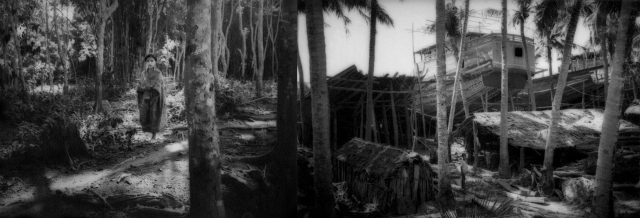I had never frightened anyone to the point of fleeing me on sight until I had some of the most bizarre series of encounters in the Tanah Towa area in the south of Sulawesi, Indonesia in 1994.
I arrived in Bira to photograph “pinisi perahu” ship building (right photo), once employed by Bugis pirates to so instilled fear in Dutch and English ship captains, they went on to coin the phrase ‘I think a saw the “bogeyman”’. The expression lives on even today but few who are unfamiliar with Sulawesi are aware of the bogeyman’s origins.
I decided to head inland for the day. Alfred Russel Wallace wrote of the interior of this peninsula in his seminal book, “The Malay Archipelago”,“…hardly any of the people appeared to have seen a European before. One of the most disagreeable results of this was that I excited terror alike in man and beast. Wherever I went, dogs barked, children screamed, women ran away, and men stared as though I were some strange and terrible cannibal monster. Even the pack-horses on the roads and paths would start aside when I appeared and rush into the jungle; and as to those horrid, ugly brutes, the buffaloes, they could never be approached by me—not for fear of my own, but of others safety. They would first stick out their necks and stare at me, and then on a nearer view break loose from their halters or tethers, and rush away helter-skelter as if a demon were after them, without any regard for what might be in their way. Whenever I met buffaloes carrying packs along a pathway, or being driven home to the village, I had to turn aside into the jungle and hide myself till they had passed, to avoid a catastrophe which would increase the dislike with which I was already regarded..then I had to creep about like a thief by back ways, for no one could tell what mischief they might do to children and houses were I to walk among them”.
Wallace would have towered over locals, lanky and lumbering in his gate. He wore a long, thick beard, formal 19th century dress typical of the 1860’s, but the one article that might have been even more startling than his beard might have been his eye-glasses. He must have seemed like a bespectacled Victorian Sasquatch to the locals.
I arrived in Tanah Towa in khaki shorts, a T-shirt, clean-shaven but still the first person I came upon was an elderly woman been bent over lost in work. Suddenly, she straightened up, looked at me as if stunned, turned and ran off! It came so out of the blue, I never made a photograph but I did photographed this young woman shortly afterwards (left photograph), standing rail-straight like an egret on one foot, looking as if she’d an apparition. She did not run away but she did not move a muscle until I had passed and was a safe distance away. Then I thought of Wallace and could not believe it happened to me too.
More photos here:
http://www.jameswhitlowdelano.com
New Stories:
http://jameswhitlowdelano.photoshelter.com/
Facebook:
http://www.facebook.com/james.whitlow.delano
Twitter: @jameswdelano
Instagram: jameswhitlowdelano

Great story James.
One goal this year is to read the works of 18th and 19th century explorers just like Alfred Russel Wallace. They must have had a hard time back then but no doubt a preferable life experience compared to the modern day comfort we have.
Next on the list is Mungo Park – a Scottish explore who travelled around western Africa in the late 1700s.
Yes, indeed. Did Mungo Park go to Timbuktu but never return? René Caillié also had an incredible voyage. He was the first European to reach Timbuktu and return (just barely) alive. He learned Arabic, studied the Quran, and baked up a story about being half-Egyptian to travel to Timbuktu from Guinea and then cross the Sahara to Morocco where he was literally chased into the French mission there. Otherwise, he would have been killed for his transgression of entering the holy city of Timbuktu as an infidel.
I’m not sure about Mungo Park yet. I need to read the book.
René Caillié sounds like he had an amazing life. I shall look him up.